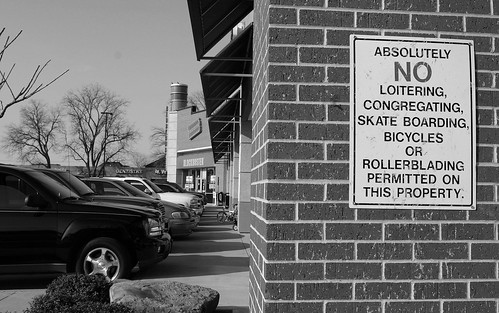
Strip malls need a makeover. Not just to look prettier, but to be safer and more accessible to pedestrians, cyclists and other people on the street. Photo by Dean Terry.
On the beauty spectrum of community design, nothing’s uglier than a strip mall, with its massive parking lots, low-lying, box-shaped buildings and uninviting walkways.
But the real beast of this type of commercial space is its lack of safety.
According to the summer issue of Journal of the American Planning Association (JAPA), “arterial roadways, strip commercial uses, and big box stores all have a profoundly negative effect on traffic safety, while the presence of traditional, ‘main-street’-type retail configurations are associated with safer communities.”
There are more crashes near big box stores located adjacent to arterial streets, and less crashes for commercial or retail areas that are designed for pedestrians.
The article, “Safe Urban Form: Revisiting the Relationship Between Community Design and Traffic Safety,” is based on three years of traffic accident data for the City of San Antonio (which is home to both the “strip mall on steroids” and the very sustainably and beautifully designed Riverwalk.)
Some of the findings:
A 6.6% increase in total crash incidence for each big box store located adjacent to an arterial thoroughfare and a 2.2% decrease in crash incidence for each pedestrian-scaled commercial or retail use.
Population density increases were associated with fewer crashes.
Each additional mile of arterial roadway within a block group was associated with a 15% higher incidence of crashes.
Eric Dumbaugh, assistant professor at Texas A&M University, says “the modern commercial arterial is a perfect storm of bad planning and design.”
These roads are designed to support high operating speeds, making it difficult for drivers to stop quickly to avoid a crash, and the presence of commercial and retail uses on these roads means that drivers will routinely need to stop quickly in order to avoid crashing into pedestrians, bicyclists, and especially vehicles turning in and out of driveways.
So how do we give these ugly — and dangerous — retail streets a makeover? Dumbaugh and his co-authors present three suggestions:
1) “Manage mobility and access functions of urban arterials.” Mobility is all about moving cars. Access is about ensuring that these vehicles can stop safely and passengers can exit securely to get to where they want to go. No more fears of getting hit by an SUV on your weekly run to Wal-Mart to buy a gallon of milk.
2) “Relocate retail and commercial uses to lower-speed thoroughfares (or reduce speeds on roads already lined with commercial uses).” Cars will slow down if they expect to see pedestrians and cyclists in their path — think more crosswalks, benches, outdoor dining, bicycle lanes and green space — and therefore, avoid crashes.
3) “Give greater attention to how land use planning may affect crash incidence.” Building roads for high volumes of cars, routing traffic away from neighborhoods, building tons of four-way intersections, and isolating residential subdivisions and cul-de-sacs create a recipe for a dangerous, auto-centric, accident-prone environment. Plus, it’s just plain ugly.
For further information about the research contact:
Eric Dumbaugh
Assistant Professor
Department of Landscape Architecture and Urban Planning
Texas A&M University
Email: edumbaugh@tamu.edu
Phone: +001 (979) 862 4320
For more information about the journal and for free access to the full article, please visit:
www.informaworld.com/smpp/content~db=all~content=a911996851
www.tandf.co.uk/journals/rjpa








